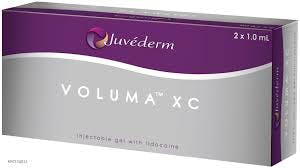
The face ages in many complex ways as you grow older. The most common changes associated with aging are changes to the skin, including spots and lines. However, these changes aren’t the first sign of age on the face.

Most people notice that they appear older when looking in the mirror, but they can’t quite pinpoint exactly what’s changed. The first and most apparent effect of aging is volume loss in the cheeks.
Rounder, cherubic cheeks have long been a mark of beauty in our culture, and they may also hold the key to aging well. Just look at Sally Field, who maintains an air of youthfulness at 67-years-old.
Although it may not be the first thing you think about when it comes to aging, volume loss can make you appear much older than you actually are, especially if you have a fairly thin face, which can appear gaunt as you age.
If you’re struggling with thinning in your cheeks, there is a way to regain that volume and restore your youthful appearance. Voluma is an FDA-approved treatment proven to battle the hollow-cheek effect.
At Shafer Plastic Surgery, we are committed to offering each of our patients a procedure that matches their needs. To do that, we have a wide selection of procedures that spans from cosmetic surgeries to medical spa treatments.
Whatever you’re looking for, you can count on us to help you reach your cosmetic goals. To arrange a consultation with an experienced cosmetic surgeon in New York, call us today at 212.888.7770.
Why does Voluma use hyaluronic acid?
You might not know it, but you have hyaluronic acid in your skin right now. This chemical compound is what gives your skin its plumpness and firmness. As you’ve probably guessed, diminished cheek volume is primarily caused by a loss of HA.
Doctors have long used the substance to treat joint disorders, such as osteoarthritis, but it wasn’t until relatively recently that they uncovered its potential for cosmetic applications.
What makes Voluma different than other dermal fillers?
First, Voluma is the only filler approved to specifically treat cheek volume loss. Other dermal fillers are designed to treat issues related to wrinkles and lines.
Dermal fillers are a favorite among patients looking to treat the signs of facial aging, but some fillers don’t last quite as long as people would like. Voluma excels in this area, as well.
Allure reports that the effects of Voluma can last for up to two years, which is much longer than the average for other dermal fillers.
What are the side effects?
Side effects associated with Voluma are rare and moderate, most often presented as itching, swelling or tenderness of the treatment site. These issues generally last between two and four weeks, but most patients don’t develop any side effects whatsoever.
If you’re interested in Voluma in New York, come visit us! At Shafer Plastic Surgery, we offer a variety of dermal fillers including Voluma, Sculptra and Radiesse. To learn more about any of these fillers during a consultation with a New York cosmetic surgeon, call us today at 212.888.7770.


